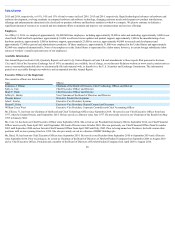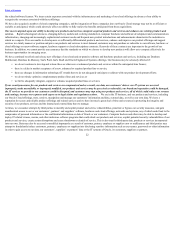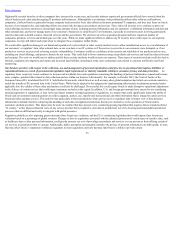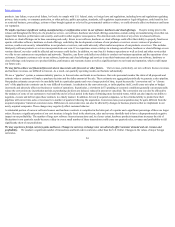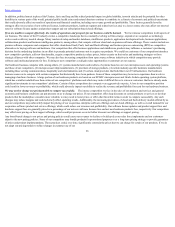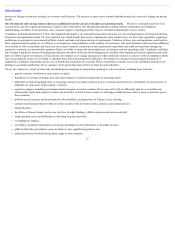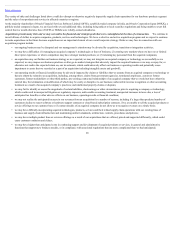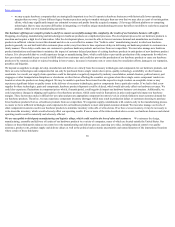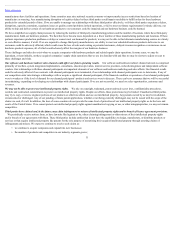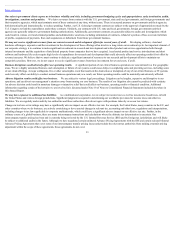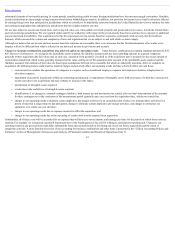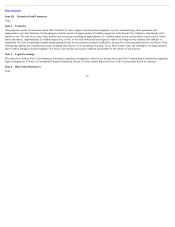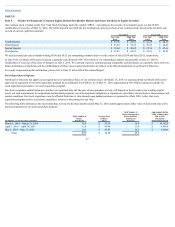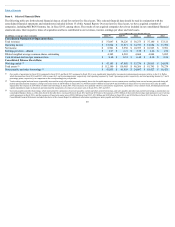Oracle 2015 Annual Report Download - page 31
Download and view the complete annual report
Please find page 31 of the 2015 Oracle annual report below. You can navigate through the pages in the report by either clicking on the pages listed below, or by using the keyword search tool below to find specific information within the annual report.
Table of Contents
• we may be unable to obtain timely approvals from, or may otherwise have certain limitations, restrictions, penalties or other sanctions imposed on us by,
worker councils or similar bodies under applicable employment laws as a result of an acquisition, which could adversely affect our integration plans in
certain jurisdictions and potentially increase our integration and restructuring expenses;
• we may be unable to obtain required approvals from governmental authorities under competition and antitrust laws on a timely basis, if at all, which
could, among other things, delay or prevent us from completing a transaction, otherwise restrict our ability to realize the expected financial or strategic
goals of an acquisition or have other adverse effects on our current business and operations;
• our use of cash to pay for acquisitions may limit other potential uses of our cash, including stock repurchases, dividend payments and retirement of
outstanding indebtedness;
• we may significantly increase our interest expense, leverage and debt service requirements if we incur additional debt to pay for an acquisition and we
may have to delay or not proceed with a substantial acquisition if we cannot obtain the necessary funding to complete the acquisition in a timely manner
or on favorable terms;
• to the extent that we issue a significant amount of equity securities in connection with future acquisitions, existing stockholders may be diluted and
earnings per share may decrease; and
• we may experience additional or unexpected changes in how we are required to account for our acquisitions pursuant to U.S. generally accepted
accounting principles, including arrangements that we assume from an acquisition.
The occurrence of any of these risks could have a material adverse effect on our business, results of operations, financial condition or cash flows, particularly in the
case of a larger acquisition or several concurrent acquisitions.
Our hardware revenues and profitability could decline if we do not manage the risks associated with our hardware business. Our hardware business may
adversely affect our overall profitability if we do not effectively manage the associated risks. We may not achieve our estimated revenue, profit or other financial
projections with respect to our hardware business in a timely manner or at all due to a number of factors, including:
• demand for competing hardware technologies such as cloud infrastructure compute and storage services, which could adversely affect demand for our
hardware products offerings;
• our hardware business has higher expenses as a percentage of revenues, and thus has been less profitable, than our cloud and on-premise software
business;
• our focus on our more profitable Oracle Engineered Systems, such as our Oracle Exadata Database Machine, Oracle Exalogic Elastic Cloud, Oracle
Exalytics In-Memory Machine and Oracle SuperCluster products, which are in the relatively early stages of adoption by our customers, and the de-
emphasis of our lower profit margin commodity hardware products, which could adversely affect our hardware revenues because the lower profit
products have historically constituted a larger portion of our hardware revenues;
• as we develop and introduce new versions or next generations of our hardware products, customers may defer or delay purchases of existing hardware
products and wait for these new releases, all of which could adversely affect our hardware revenues in the short term;
• a greater risk of material charges that could adversely affect our operating results, such as potential write-downs and impairments of our inventories;
higher warranty expenses than what we experience in our cloud and on-premise software and services businesses; and amortization and potential
impairment of intangible assets associated with our hardware business;
• we may not be able to increase sales of hardware support contracts or such increase may take longer than we anticipate, which could result in lower
revenues and profitability, or slower than expected growth of such revenues and profitability; and
29



